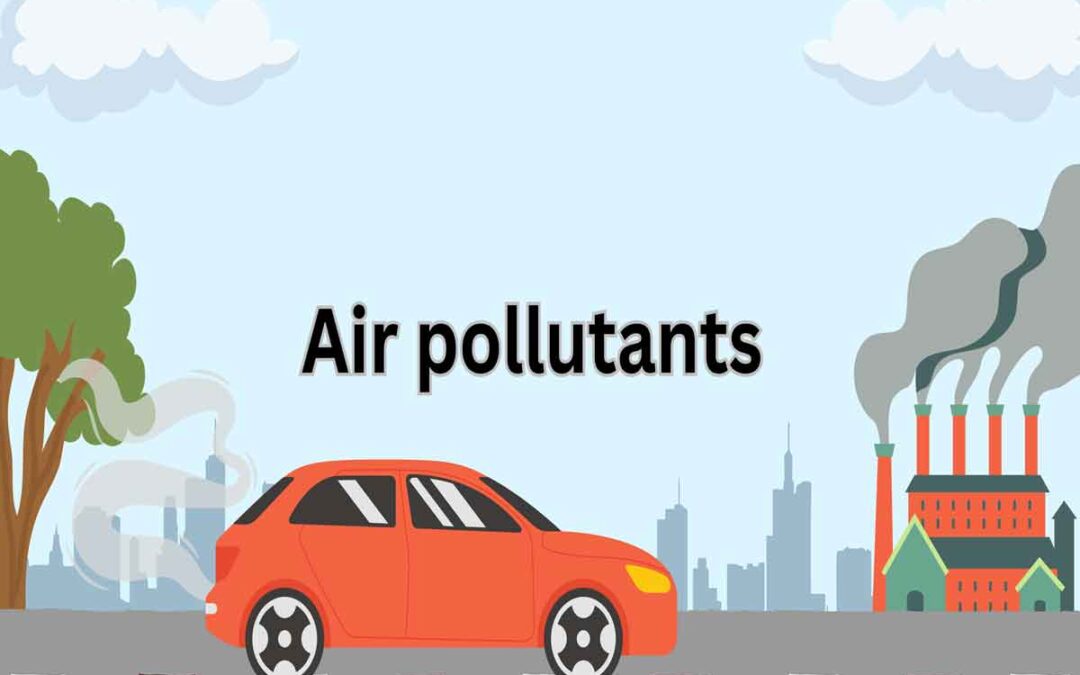Air pollution is a major environmental challenge, affecting health, ecosystems, and climate worldwide. At the heart of the problem are air pollutants, which degrade air quality and harm human health and the environment.
Air pollutant:
Substances present in the air are known to have the potential to cause harm to people and the environment. Example: NOx, SOx, COx, CO2.
Classification of Air Pollutants:
Air pollutants may be natural, such as wildfires, or maybe synthetic (manmade). Air pollutants are
classified as primary pollutants and secondary pollutants.
Primary air pollutants are released straight into the atmosphere from their sources. Some examples include particulates, carbon monoxide, nitrogen oxide, and sulfur oxide.
Secondary air pollutants are formed by reactions of primary pollutants with other elements in the atmosphere, such as ozone (O3), sulfuric and nitric acids (components of acid rain), particulate matter, nitrogen dioxide (NO2), and peroxyacyl nitrates (PAN).
Various types of Air Pollutants:
Carbon Monoxide:
Carbon monoxide is a gas that you can’t see or smell. It’s commonly produced by vehicles and in smoke from fires. This dangerous gas can prevent your body from getting enough oxygen, leading to symptoms like headaches, tiredness, vision issues, and in extreme cases, it can be fatal.
Sulfur Dioxide:
Sulfur dioxide is produced when coal or kerosene is burned and is also found in exhaust fumes from power plants. Contact with this substance can cause the airways to constrict, resulting in wheezing and shortness of breath.
Nitrogen Dioxide:
Nitrogen dioxide is a primary and secondary air pollutant. It forms in the atmosphere when nitrogen reacts with oxygen. Exposure to nitrogen dioxide can lead to respiratory infections and various other respiratory issues.
Particulate Matter:
Particulate matter consists of a mix of particles of varying sizes that enter the atmosphere from multiple sources such as fossil fuels, dust, smoke, and fog. When inhaled, these particles can accumulate in the respiratory system, potentially worsening heart and lung conditions and raising the likelihood of respiratory infections.
Ground-Level Ozone:
Ground-level ozone forms when emissions from vehicles, power stations, and factories mix in the atmosphere. This type of ozone can cause significant irritation to the airways and hinder lung function, which can trigger asthma symptoms.
Smog:
Smog is formed when gases combine with water vapor and particulate matter. This occurrence takes place as heat and sunlight engage with these gases, a process referred to as photochemical smog.
Sources of Air Pollutants:
Natural Sources:
- Volcanic eruptions release gases and ash.
- Forest fires generate smoke and particulate matter.
- Dust storms and methane from wetlands.
Human-Induced Sources:
- Industrial Emissions
- Transportation
- Agriculture
- Household Sources
Effects of Air Pollutants:
The impact of pollutants on human health can’t simply be inferred from basic biological or physiological principles; it requires careful experimentation. We can envision studies involving animals or willing human participants that examine health effects caused by short-term exposure to artificially heightened pollution levels.
However, translating findings from these short-duration studies to longer-term, lower-level exposures presents challenges. Certain pollutants may have certain threshold concentrations below which certain health effects do not occur.
This means that making predictions based on a straightforward relationship between exposure and outcome might not be accurate. Moreover, chronic exposure can lead to harmful effects that might not be present in brief, even severe, exposures.
It’s no surprise that the most significant health impacts from air pollution are seen in the lungs. For instance, individuals with asthma often experience more severe symptoms when levels of sulfur dioxide, ozone, or particulate matter in the air increase. Research conducted in California indicated that air pollution, particularly ozone, can trigger asthma, particularly in active children who inhale more air.
Another study in British Columbia found that exposure to traffic-related pollutants such as NOX and CO during pregnancy and the first year of life raises the likelihood of developing asthma later in childhood.
How to reduce air pollutants?
Carpool, hybrid cars, EPA-environment pollutant agency government regulation, alternation fuels.
Conclusion:
Air pollution is a serious threat to public health, the environment, and the climate. Solving this problem requires collaboration between individuals, government agencies, and businesses. By better understanding the types, sources, and impacts of air pollutants, we can take effective action to ensure cleaner, healthier air for future generations.
FAQ’s:
- How does air pollution affect the climate?
Air pollutants like greenhouse gases contribute to global warming and alter weather patterns. - What part does technology play in lessening air pollution?
Innovations like air filters, renewable energy, and emissions monitoring play a key role. - Can air pollution be reversed?
While not entirely reversible, its effects can be mitigated through proactive measures and policy changes.






